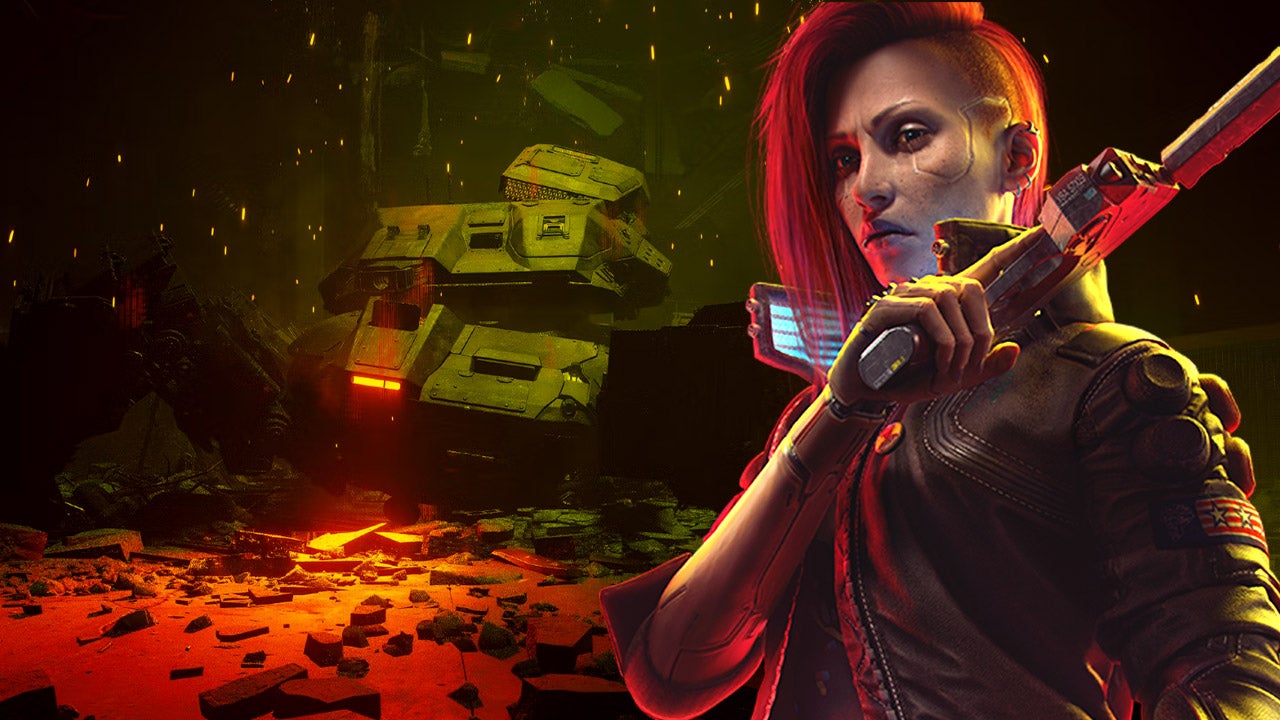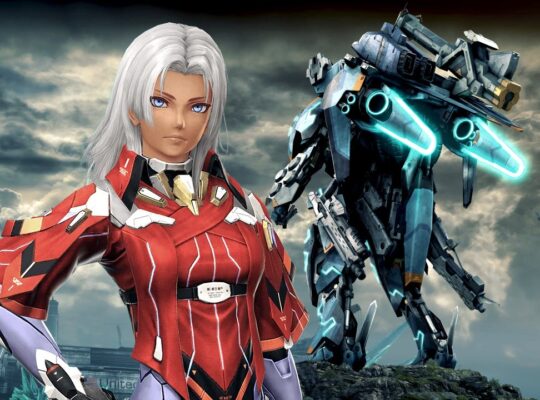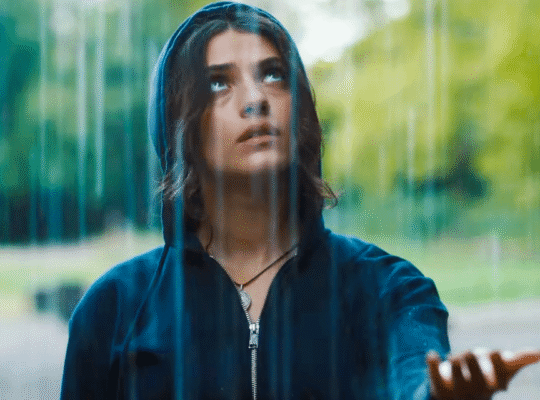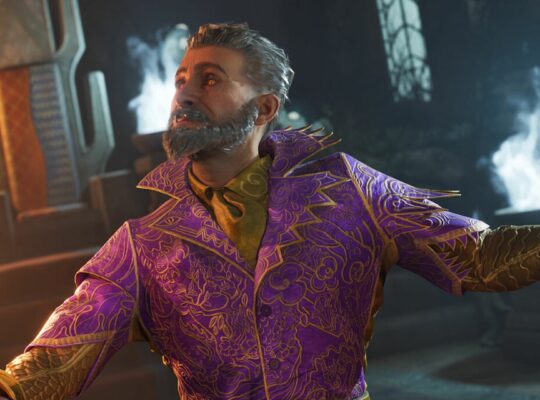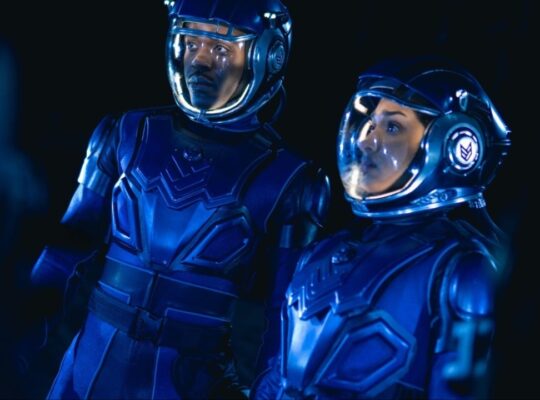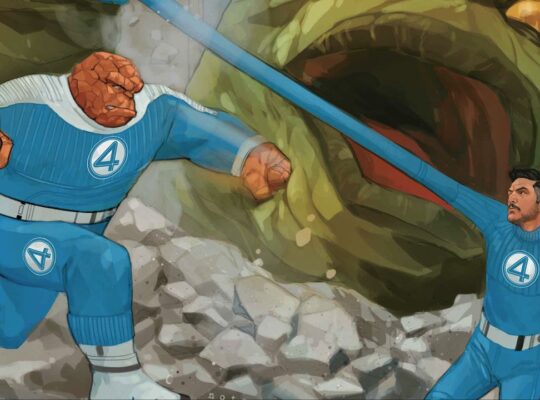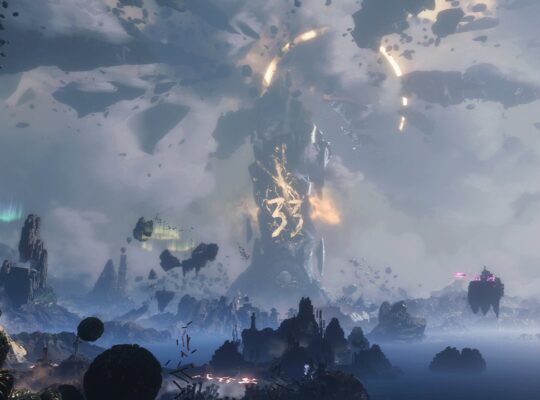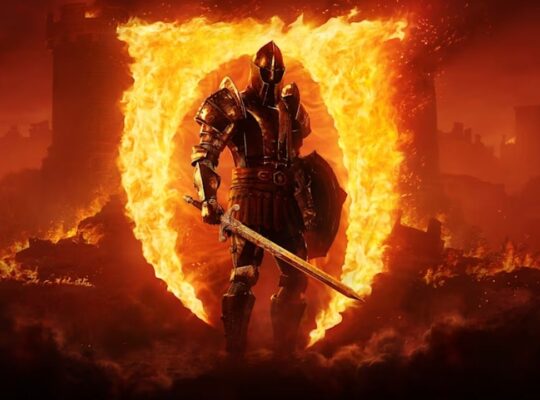If you’ve played Cyberpunk 2077: Phantom Liberty, you’ll no doubt remember the Chimera. It’s a hulking, spider-like tank that chases you relentlessly, destroying every piece of the building around you before trapping you in a one-on-one battle. It’s the biggest boss fight in the whole game, and was a monumentally complex sequence for developer CD Projekt Red to create.
So, how was this intricate multistage mission put together? We spoke to multiple developers from across several different departments to find out what the joys and complications were. This is how Phantom Liberty’s Chimera encounter was built, from concept to controller.
The thoroughly elaborate design process for the Chimera started with the most simple of propositions: a big boss battle with a big boss tank. Filippo Ubertino, Cyberpunk’s Senior Concept Designer explains:
“I had a very small brief and it was something like this: we want to do a boss fight that will be a spider tank. Internally, we always refer to it as a spider tank, but in fact it’s not a spider because it has six legs, so it’s not really a spider and it’s not actually a tank because it doesn’t have a crew. So Chimera fits better.
In the beginning, we didn’t have this claustrophobic environment in mind. So we also thought about maybe we could have this tank jumping around, but we decided that we wanted something heavier, something scary in a sense, not like a toy jumping around.”
That desire for heft and weight informed the complete look of the Chimera. It almost evokes kaiju-like monsters, further playing into the metaphor of it destroying the model of Night City’s Dogtown district at the centre of its museum home. It was built to impose itself on both the tight confines of its surroundings and the player, who is tiny by comparison, something Paweł Mielniczuk, Art Director at CDPR, expands upon:
“We thought that it would be perfect [to create] this kind of man versus machine, David versus Goliath moment where we have to, as a single person, fight with something so massive and elaborate and powerful. There were a lot of iterations on even an accomplished model. Changing something, replacing things. Adding range, the capability of rotating faster, moving faster, et cetera. Adding grenade launchers. Eventually also adding the drone compartments, which were not part of the original design, but were needed to add an additional phase of combat in the third stage of the boss fight.”
“We didn’t have a perfect gameplay idea at the beginning,” Ubertino reveals. “So we started with [lots of different ideas;] many legs, high legs, something smaller, something bigger. And when one of those sketches was chosen, we were like, ‘Okay, now we need to block it out.’ So we have very rough 3D models so [the gameplay team] can test it in the level. That one was a little bit more similar to the final one. I tried to keep the shape as similar to that block out, even when I started adding details in 3D and making it more believable, more like a real tank.”
But despite being neither a spider nor a tank in the end, the eagle-eyed among you will be able to spot some aspects of the original design that remain to this day. Something that Ubertino found the perfect way to repurpose.
“If you look at the rear section, there’s quite a big door. At the beginning we didn’t know that we were not going to use a crew, so that door was supposed to be the opening for the crew. But we ended up [making the Chimera] a huge drone essentially, and the door is still there.”
Being an automated machine rather than a crewed vehicle allows the Chimera to move in a more animalistic way. Unhindered by the limitations of humanity, its motions are free to be animated in a way that better reflects its natural world influences, as explained by Cinematic Animation Acting Lead David Cordero Iglesias:
“We were mostly relying on scorpions, beetles, things that have six legs, because it’s very important to pick up the balance on how he’s moving, the volume motion that the Chimera showed through the entire sequence.”
Contributing to that animalistic-yet-mechanical feel is the fact that the Chimera is possessed by a rogue AI from beyond the Blackwall. This ‘cyberspace hell’ and the corruption it inflicts is at the core of Phantom Liberty’s storyline – and would also need to be conveyed in the way the metal monster would be heard. As such, noises were engineered to sound like nothing else – an amalgamation of natural, digital, and demonic worlds. It needed to sound like an overwhelming force eating away at whatever it came into contact with, be that the hulking Chimera or the new central character, Songbird – it’s an audio hellscape she, nor the player, can escape.
“We wanted the Chimera to sound mechanical but not fully robotic”, states Lead Sound Designer Krzysztof Popiel. “We wanted it to be something alive, and robotic growls help a lot with this. As the sequence progresses, the vocalisation of the Chimera changes to almost demonic Blackwall sounds.”
It’s a sentiment echoed by Michał Pukała, Senior Sound Designer: “I think the coolest and the most interesting thing about Blackwall is that it wasn’t supposed to be futuristic. The descriptors I got from both the narrative director and the lead cinematic designers, they were talking about shamanistic sounds, cyber monsters. Essentially you would need to create sounds of cyber hell.”
Further inspirations for the sound of the Blackwall came from other, non-audio departments working on the sequence. This collaboration was made possible thanks to a completely new organisational system, implemented by CD Projekt Red after the release of Cyberpunk 2077. The Spider and the Fly, the mission in which the Chimera appears, was a big test subject for this new way of working. Members of every design department needed to be in constant conversation with one another to ensure that the visual design and animation all worked in concert with the sequence’s gameplay goals.
This sequence is one of the biggest achievements we did in terms of blending gameplay with cinematics.
“It was a bit tricky from our side because it was the first time in the company that we were divided into what is called content teams”, Iglesias recalls. “It’s like a multidisciplinary team based on every discipline that we want to create this sequence. So everyone participated in the design with their own ideas. We have environment artists, we have animators, we have designers, we have gameplay, we have level design, so everything together to create the best approach to this. It was a very, very, very intricate process.
We needed to have this heaviness, this weight, tons of steel chasing you. But at the same time, later we have a boss fight. So we have to balance it out with gameplay that has other requirements, right? Because this sequence, for me, is one of the biggest achievements we did in terms of blending gameplay with cinematics. We tried all the time to mix those two in several intensities during the whole sequence.”
Blending gameplay with cinematics is something that Cyberpunk 2077 does elegantly. CDPR aims to never fully take control away from the player, even when a scripted scene is playing out in front of them. The Chimera sequence is a finely tuned set piece that demanded a tight relationship between the gameplay and cinematics staff. Managing the balance was a task that largely lay in the hands of Cinematic Designer Michał Zbrzeźniak:
“When the tank is rising up for the first time in this room and he’s shooting at you in the middle of his animation, that makes him go to gameplay. So normally you would have a cut, a fade out and fade in, or maybe something will glitch at the transition from gameplay to scene. And in Cyberpunk, especially in this sequence, we always strived to make it invisible.
So actually almost the whole sequence, except for maybe just the fight itself, is actually a cinematic sequence. There are dialogues being played by the characters. There are even contextual animations played on V where she’s covering her face from the missiles. But the soldiers that are on the balconies actually have gameplay behaviour. But we did it in a way [where] the turret’s swipe is so meticulous that they will die anyway. So it’s kind of a risky mix, but it worked out in the end.”
From here, the mission transports you from the wide open museum space to a tight corridor, made even more claustrophobic by the presence of the Chimera hunting you down. It’s a chase sequence built on the principle of knowing when to pick your battles. The tank is too powerful to take down by yourself, and if you try, you’ll learn that the hard way.
“We kind of try to make sure that it’s impossible to fight with it”, Iglesias explains. “There are several fail states that we create along the whole sequence, but I will say 90% of the players run away the first time because it’s too scary.
It was a bit of a challenge to put this gigantic beast inside the corridor because it’s pretty difficult to make him move anywhere. So we decided that he’s destroying everything on his path [as he chases you]. It was the best way to create this horror feeling. [It’s] funny because I animated everything with the Chimera moving forward and destroying everything on his path, and probably 99% of the players don’t look [backward], which is kind of sad for me.”
Running forwards may be a simple enough task for the player, but was far more complex a conundrum for Zbrzeźniak and the cinematics team to solve:
“So the chase part was a challenge in that regard. We had to align the speed of the tank, which wasn’t an easy task to do because it was completely animation-driven. So any change in his movement would require some animation tweaks. [We also had to] align that with how fast the player can go, because the player can be a bit faster or a bit slower [depending on their character build], and for every type of build it still needs to work and it still needs to feel like he’s right on your toes. But he can never catch you if you are actively running from him.
One of the goals in the sequence for us was to foreshadow as much of the stuff the tank is doing as possible. For example, you shouldn’t be close to it. Being close to it means death. He has a turret that is deadly, he has a laser swipe that is also deadly. So then when you actually fight him, you know what a given attack is because we showed it already through the sequence that precedes it.”
Before the big fight, though, comes a long fall. A floor-shattering descent through concrete and metal, this incredibly complicated transition scene posed some of the biggest technical challenges of the whole sequence.
“That fall was kind of my own personal baby, actually”, states Iglesias. “I wanted to create a bigger action sequence instead of just falling. So I took some inspiration actually from some other places. For example, the Uncharted 4 clock tower sequence. You are trying to grab onto everything you find for your life, right? We have these cables, you are on top of the tank again, and you have to jump out [and grab them].
At the same time, to give this scale, I had another inspiration that I like a lot: Gandalf falling with the Balrog from the Bridge of Khazad-dûm [in The Lord of the Rings: The Two Towers]. So it’s this massive fall, but you are still fighting and you have this behemoth by your side that you are watching fall with you. In the end, trying to achieve this result of an insane action sequence was very, very difficult from an animation point of view.
What we did is we had an incredible [motion capture] stunt team that we recorded for several days and we divided it into several clips. So you have your fallings – everything is recorded actually in motion capture, which looks insane – but everything is recorded from the ground level. Of course, we’re not throwing anyone three floors down. Later we have to cut and clip everything, cut and paste every single bit, so it makes sense.
It was incredible to work with that, but it was kind of a gigantic puzzle to build all these animation clips while at the same time having this Chimera keyframe animated on top of it and trying to sync everything. This was a very close collaboration with cinematic designers to try and nail that timing together with this insane action sequence.
“For the longest time we couldn’t really make it work”, Zbrzeźniak adds. “We needed to be like, ‘This will work eventually, please trust us, we will make it happen’. But there were some tricks that we had to do there. For example, when V is falling down through the air, when you actually would fall [in real life], you would fall much faster. But we had to kind of fake it a bit to achieve a better effect and to also make it readable because in sequences, especially first-person ones, everything that you see is dictated by your perceivable angle of vision. And so we really had to be careful on what we present [to ensure that]the player even understands what’s happening in that sequence. Achieving that wasn’t an easy task and it went through many, many iterations.”
What looks like a simple fall actually turned out to be the most complicated part of the sequence for the cinematics team. Ensuring that the most scripted of events looks reactive is an art they put a lot of time and effort into perfecting.
We try to never take full control from the player for too long. It’s kind of like a rule, like a philosophy of ours.
“Nothing there is procedural”, Zbrzeźniak continues. “Everything needed to be directed by us and put in a very specific, deliberate place. [We had to make sure that the] destruction that is happening [occurs] at the very precise moment when you’re falling through that concrete floor. The smoke needed to go off at the very precise, specific moment. The pieces of debris needed to clear out for you to be able to see where you’re falling. And it needed to be clear that you fall down on the tank and roll off from it. So putting this specific part of the sequence [together] was certainly the most challenging, but also the most fun.”
While this sequence delivers cinematic spectacle in spades, Cyberpunk is a video game, not a movie. As such it’s important that there are still flashes of interactivity through the most scripted of scenes. Not paying attention? Deadly quicktime events will make you pay the price. Zbrzeźniak explains how:
“We try to never take full control from the player for too long. It’s kind of like a rule, like a philosophy of ours. There cannot be [non-interactive] scenes that are too long, basically. And so on top of it being already difficult and containing multiple elements to piece together to work in perfect sync, we also made it so that you can get hit by the turret if you don’t react quickly. If you don’t manage to grab the cables, you will bounce off them. And if you don’t dodge the spider tanks leg, you’ll get crushed by it.
“We wanted to kind of test the streamers a bit. Sometimes during the scenes they just tend to look at the chat, maybe not pay full attention to what’s happening on the screen. And in this case, and actually we witnessed it several times, they just died in the middle of the scene because they weren’t paying attention. That’s exactly what I’m talking about when we talk about scenes in Cyberpunk. You can never really look away. You can never put down your gamepad and just witness the events.”
The biggest challenge for the player was yet to come, however. After landing, the briefest of respites is granted so that you may gain a bearing of your surroundings. Savour those few seconds, though, because it’s the calm before the biggest storm Cyberpunk has to offer. What was previously seemingly indestructible is now weakened, but that doesn’t mean it won’t put up one hell of a boss fight.
The fight itself tasks you with taking on the Chimera and its many, many different weapons. It’s here that the design of the tank and the design of the gameplay scenario all comes full circle, with gameplay influencing visual design and vice versa. It’s something that influenced Mielniczuk and the art team’s ever-evolving iterations:
“In the early pre-production of Phantom Liberty, the combat was supposed to happen on the street level. So we were thinking about ranged combat, larger distances, a big arena. Eventually, in the process of designing the expansion, we decided that it would be all held inside the buildings and, eventually, in the abandoned metro station.
When we ended up with the design of enclosing the whole arena in the interiors, it completely changed the game. So we needed to adjust a few things, but there was a constant negotiation with the gameplay team. In the beginning, I remembered they wanted to have a really fast and agile robot that runs over the ceiling and the walls, and it’s all over the place. We wanted to have something super heavy, static, slow, inspired by Ghost in the Shell. So finding the compromise, it took us quite a time, but we found it.
The arena’s not too big, not too small. Also, the device itself, which is designed to fight on the medium and long range, now has to deal with us, the small opponent, which is walking, running around their feet.”
Through player testing it was discovered that further tweaks to the tank’s design would need to be made. “There are many weapons on that tank and some of them were added very late,” recalls Ubertino. “For example, we found out that being in the middle of the level, if the character goes too close to it, you can keep shooting [with minimal danger]. So we added this [sweeping] beam just to make the player go far away from it.”
For the sound of the laser, Popiel and the sound team conveniently had the perfect reference point. “We had this case of the laser weaponry in the base game, when you were fighting in Royce’s boss fight, and he was using this laser weapon that can sweep the environment. So with the Chimera, we wanted to do it x10. So basically what we went for here is this constant feeling of the threat, but also it needed to give the player information that the laser gun is winding up to give them a chance to hide behind cover and avoid the damage.”
It wasn’t just the Chimera’s weapons that needed to be tweaked over time, though. Its armour also needed redesigning. Ubertino continues:
“Once we had a blockout, I knew that we needed armour, so I started designing the armour and what’s underneath the armour and which places we wanted to be destroyed. We also worked with weak spots and we wanted to reveal them in a sense. We used the Kiroshi eyes [cybernetic ability] to reveal them, so you just need to scan and you see them. So I didn’t really need to make them yellow or too obvious. It would also be kind of stupid for a weapon to show his weak spots. So using the Kiroshi eyes, it’s a fantastic solution.”
It’s another great example of gameplay and art design working in tandem, and it and other similar combinations all build to the fight’s grand finale. After exploiting the Chimera’s weak spots and disabling it in spectacular fashion, it’s time to deal the killing blow. That finisher, involving the tank’s beating mechanical heart, is the perfect example of every department of the content team coming together.
“This whole boss fight is this story arc of the tank first being indestructible, impossible to defeat. And we wanted this feeling to slowly, over the course of the sequence, to shift and make you as a player feel more and more empowered”, Zbrzeźniak explains. “Finally the finisher, we wanted to do this kind of exclamation point after the boss fight to really make the tank go out with a bang. We assumed that you’re going to be struggling with this guy for quite a long time, and we wanted you to really feel good when you finally destroy it.”
“So we have this Chimera core that resembles a heart,” says Iglesias, “and that was kind of a conversation internally because we said, ‘What looks cooler than having heart beating, heart of your enemy in your hand before you finish them off?’ Later it was super cool because with this multidisciplinary content team, we managed to even make it a piece of loot so later you can craft something out of it. So it is just a very cool ending for it.”
“The gameplay guys [told] me kind of late in the production that they wanted something to be used by the player, and I was kind of lucky in that case because I had just the spot for it”, Ubertino recalls. “So yeah, I got lucky there. There’s a cylinder in the top with a hatch that you can open, take the heart, toss it, and destroy it.”
“We wanted the heart to sound consistent with the Chimera’s approach to sound design, where it needs to sound organic and mechanical at the same time”, adds Popiel. “I think there’s a really cool thing when you just open the hatch and you can actually start hearing the heart beating and then once you grab it and rip it off, you can hear it’s basically dying.”
Teamwork, does, in fact, make the dream work. But, in a level full of towering machines, crumbling architecture, and complex scripting, you’d perhaps expect something explosive to be the biggest challenge the team faced. Well, turns out it’s actually all in the much smaller details, Zbrzeźniak tells us:
“The small thing actually was to make Myers’ rifle be attached to her back when it was necessary. You’ will not believe how many issues we had with this one. Sometimes the rifle was going directly through her head. This was probably the biggest issue for us in this entire sequence, the small rifle from Myers.
If you look at our game, there’s never a situation where characters put guns on their back. It just doesn’t happen. But she has a rifle, and since this is a main story [quest], we didn’t want to create this artificiality where the rifle is just disappearing when she’s putting it away. So we had to come up with a method of her putting the rifle on her back and then taking it out again seamlessly. We had it easier at the beginning because Myers had a pistol, not a rifle, so it was simple. She would just hide it in her pants and that’s it, end of story. But no, it was decided that she needs to have a rifle, and the rifle then needs to be a reward for the player. And it created a bit of a complication for us. But it was all fun and games.”
All fun and games, and months and months of hard work. The Chimera encounter is one of the standout moments of Cyberpunk 2077, a complicated beast at the heart of the Phantom Liberty expansion that wouldn’t have come together without all of the different disciplines at CD Projekt Red combining forces tightly. It’s a mission with as much heart put in as is taken out of its central beast, and as cool as the metal panels that shield it.
Simon Cardy might get himself a pair of mantis blades for Christmas. Follow him on Twitter at @CardySimon.


